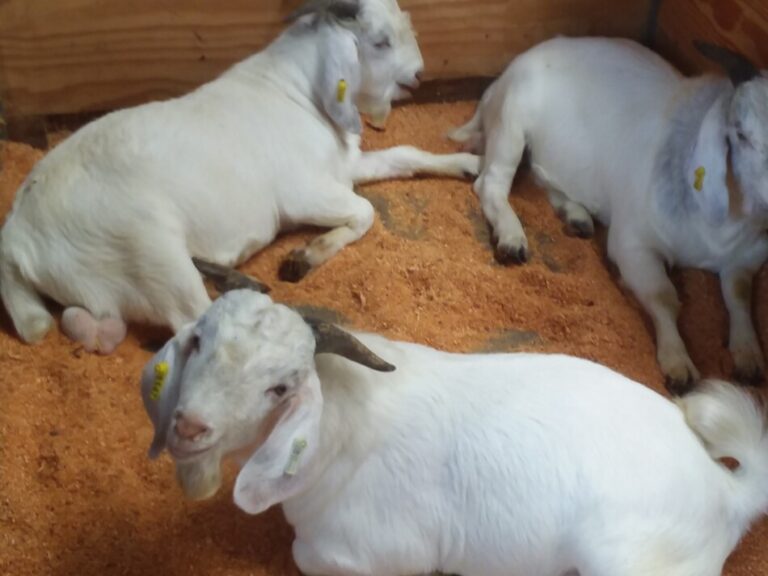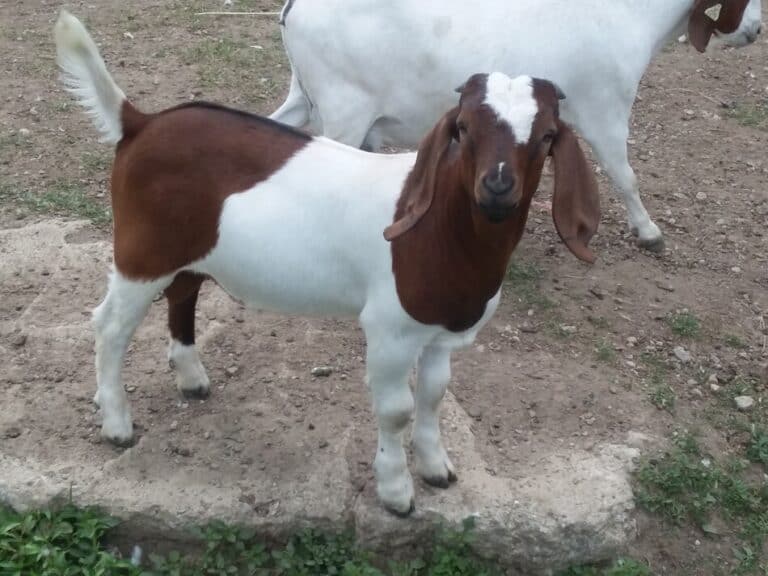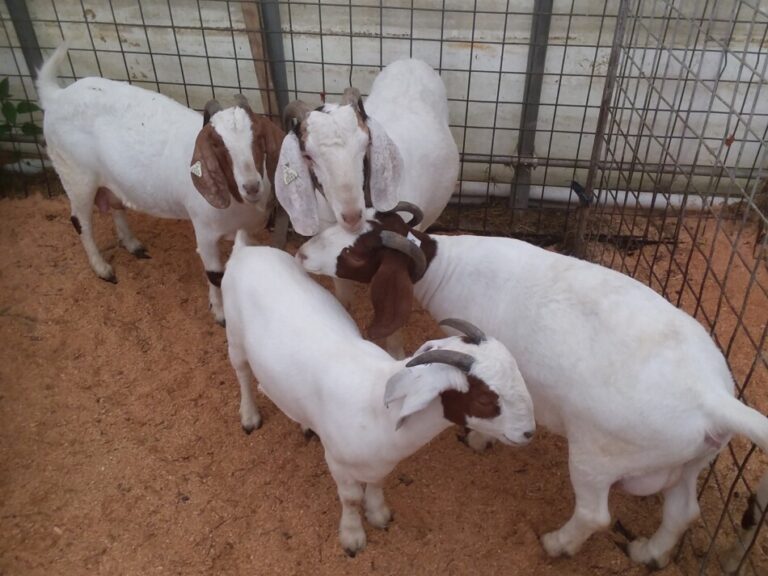Feeding Goats For Beginners: What To Give Them And How Much They Need
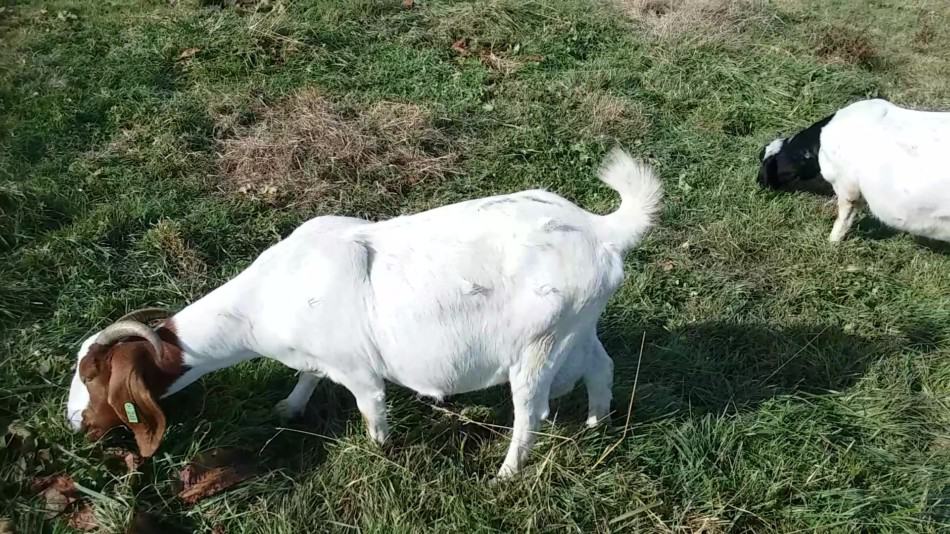
So, you’re excited about getting a starter herd of goats! Awesome, goats are fun!
However, feeding them can be a challenge due to lack of information on how to do it. Let’s dig in and get this figured out!
Goats need a high quality 14-18% protein feed and 2-5 pounds of forage each, per day. Specific amounts depend upon the specific goat (age, growth rate, etc.) and the total ration being fed.
Goats seem to be the farm animal with the most inaccurate (or non existent), feeding information out there, yikes!
We all have seen the cartoons with a goat “eating” a tin can. The whole tin can thing is misleading, common sense tells us that.
Unfortunately, that still leaves the question: what is the appropriate way to feed your goats?
Looking for more specifics on raising goat, specifically the costs involved? Read my article Thinking Of Getting Into Meat Goats: Costs Of Getting Started.
Feeding Your Goats
Here are the four basic feeding categories you will need to figure out for your goat herd:
- Water
- Roughage
- Grain (also called concentrates)
- Mineral
Water-the most important “feed” ingredient
It may surprise you to see water as the first part of the feed section, but it really shouldn’t.
Nothing, and I mean nothing, will influence the health and whole body functionality of your goats like water.
There is no substitute for plentiful water and all body processes depend upon it.
Even if the rest of the goat’s ration (daily eating) is perfect, limited water intake will restrict the ability of the goat to grow and use the feed you gave it.
Allow your herd to perform up to their potential by giving them unrestricted access to plentiful, clean water.
How much water do they need? Water needs will vary with the season, their ration and size of the goats.
Here’s the non specific, but super accurate way to handle the water needs for your goats-make sure they never run out! Seriously, it’s simple and effective.
Anytime you come back to check on them, there should be some clean water leftover from last time. If not, you need to provide more clean water per day.
Roughage for your goats
Goats are ruminants (they chew their cud) and like all ruminants, they need the biggest part of their daily diet to be roughage.
Roughage is the fancy term for whole plant materials, like leaves and stems of hay, that your goats would be eating.
Goats need to have the majority of their diet to be roughage, in order for their digestive system to work well.
Goats need around 2-4 pounds of roughage each, per day, if they are also getting concentrates. If they are eating roughage only, it is more in the 5 pound range.
I’m pretty sure you are hoping for more specifics than this: 2-4 (maybe even 5) pounds is no where near exact! So true.
That’s because this is one of those “figure it out as you go” things.
Feed, especially purchased forages, will vary from year to year.
This is a completely normal challenge for all livestock enthusiasts, not just those of us with goats! How do you handle this variability? Easy, by paying attention.
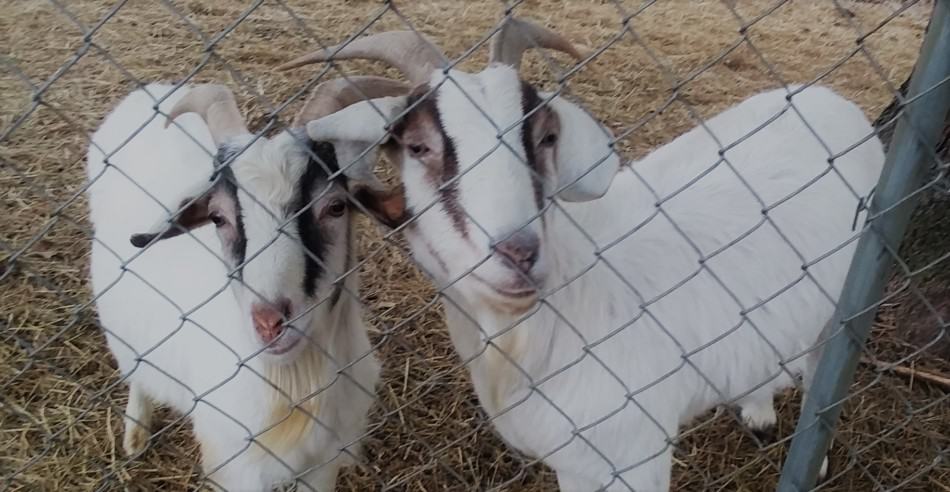
Are they getting enough? Watch your goats
No one else knows your goats better than you, even if you are new.
Knowing how your herd was fed at the farm you bought them from is a great start, but only a start.
You need to watch them, see how they are doing and adjust as needed.
How do you know when to adjust the ration? Are your goats active, with nice looking hair coats? Then they are probably fine.
If they are under or overweight or have scruffy hair, something is out of balance.
If you haven’t dewormed lately, start there, a wormy goat will look junky no matter what you are feeding her. If that didn’t work, change what she’s eating.
Roughage options for goats
What are your roughage options? Pasture is an easy one, remember that goats are browsers so they are searching for weeds and stemmy plants, not just grass.
Two of our does, pictured above, are in the pasture, eating grass. If you look closely, you can see the red head thinking about some weeds.
High quality hay is another easy and common option. Please note the high quality part.
Goats have a fast digestive system (meaning the foods they eat have less nutrient extraction time in the gut), so they need higher quality hay to get the nutrients they need to thrive.
You’re looking for a high quality, well timed first cutting grass hay, most second cutting grass hays or some alfalfa. In our area people would call this horse hay or dairy cow hay.
Goat hay buying tip:
Word to the wise-don’t say you need goat hay. You could get junk, people are still thinking about those tin can eating cartoons!
Emphasize that you need high quality, palatable hay to feed your fast growing market goats, even if you are keeping the kids!
Focusing on the need for high production and nutrition will make more sense to hay sellers that are not fellow goat enthusiasts.
And, hopefully, help them move past the tin can thing!
In case you are interested: the best site I have found regarding goat information is Onion Creek Ranch. Read the newsletter called “Meat Goat Mania”, it’s packed full of great information.
Do you need to feed your goats concentrates?
The answer here is probably yes, but like most other parts of livestock husbandry, it depends upon your goats and your management.
If your goats have slick hair coats and good body condition (fat) then they are getting what they need.
The additional energy that supplemental concentrates would provide will only make these gals fat, not good.
However, it is more likely that your goats will need some supplemental concentrates in addition to their daily roughage.
If you have meat goats with babies or milking dairy goats, plan on feeding the concentrate.
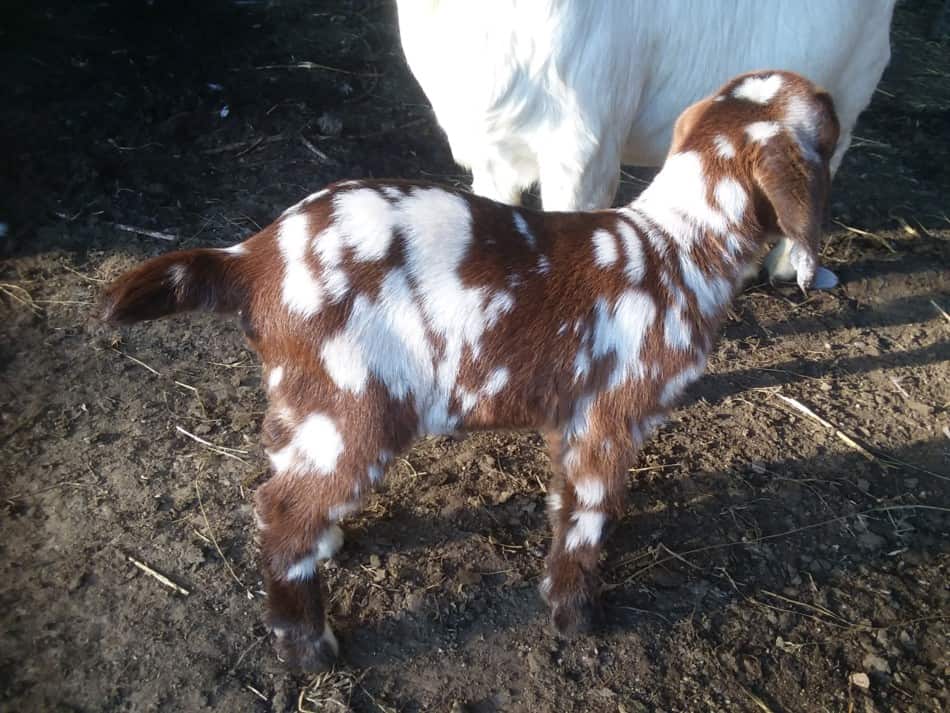
If you plan to have a low input herd, no concentrates at all, make sure of two things:
- The no concentrates system is appropriate for the genetics of your specific goats
- You are willing to wait longer for the kids to grow
Low to no concentrate goat raising is doable, multiple people are making it happen.
Please keep in mind, this system requires quite a bit of management and not all goat genetics will work for you.
For the best start, buy your herd from someone who is successfully raising goats the way you plan to raise your goats.
Minerals for your goats
Goats need to have access to minerals all of the time. When given the option, they will try to self correct any imbalances that are in the ration.
Even if you are feeding a “complete” feed, they still need access to free choice minerals.
Keep a mineral feeder with loose minerals available to your herd, not the block.
If you goats really need to take in a lot of mineral at once (this seems to be how they do it), then the block takes too long for them to get what they need.
Minerals for goats and sheep together
A note to anyone feeding sheep and goats together-the mineral that is appropriate for the sheep is not giving your goats what they need.
Don’t put the goat mineral out for both, you’ll hurt the sheep (the sheep can’t take the copper).
The easiest thing to do is to keep your sheep and goats separate.
They are very different animals as far as how they act and what they need to eat daily.
Really, the only things sheep and goats have in common are being small ruminants and sharing parasites, another reason to keep them separate!
Concentrates for your meat goats
Concentrates is just the fancy term for grain or pellets fed to goats.
Just like roughage is a term that covers all plant materials that a goat would eat, concentrates covers all high energy supplemental feeds that your goat would be eating.
Meat goat kids are growing machines! In order to keep up with the fast growth of the kids, a doe will needs some extra daily energy in her diet.
That will need to come from really great quality forages and supplemental concentrates.
Replacement doelings will need to be well fed to reach breeding age and size efficiently, this saves you money!
For market kids, keeping them well fed and at a higher rate of gain will make the best use of your time and resources.
A well fed goat pays you back sooner! For more information on profitability read my article Are Meat Goats A Profitable Small Farm Business?
| Goat age or stage of production | % Protein needed | Amount of feed needed (in pounds per head per day) |
| Goat Kids | ||
| Creep feed | 18 | .25-.33 |
| Weanlings | 16 | .5-.75 |
| Grower/Finisher Kids | 14 | 1 |
| Main Herd | ||
| Flushing | 14-16 | 1-3 |
| Gestation | 14-16 | .5-1 |
| Gestation-last 6 weeks | 14-16 | .75-2 |
| Lactation-single kid | 14-16 | .75-1.25 |
| Lactation-twins+ | 14-16 | 2 |
| Replacement Doelings | 16 | .5-1 |
| Bucks | 14 | up to .5 maximum |
Concentrates for dairy goats
Dairy goats need supplemental grain to produce more milk. Concentrates are especially important to have available for the younger goats.
For the replacement doelings, you want to make sure they grow and reach breeding age and weight, in a timely fashion.
Well grown doelings will perform better in your herd and are worth more should you decide to sell them.
For your market kids, you want to keep them growing at their best to get them to selling weight.
Market kids, both dairy and meat type, are in high demand.
Efficient raising and selling of market kids is a great way to bring more cash into your diary operation!
| Goat age or stage of production | % Protein needed | Amount of feed needed (in pounds per head per day) |
| Goat Kids | ||
| Starter | 18 | free choice |
| Grower/Finisher | 14-16 | 1-1.5 |
| Adult Does | ||
| Dry Does-6 weeks before freshening | 14-16 | 2 |
| Lactating Does | 14-16 | 1 pound of grain for every 3 pounds of milk produced |
Places to look for more information
Here is a link to a chart where I sourced the above information.
It is the best chart I have seen so far that lists out the feed needs of goats of differing ages and growth stages.
In case you are not aware, the company that made this chart does sell grain (so they are very pro grain/concentrates), none the less, it’s a great chart. https://www.admanimalnutrition.com/webcenter/content/conn/WCC1/uuid/dDocName%3Awctrprd_002886
Another great resource is Oklahoma State University. They have quite a bit of information online, written and videos. Here’s a link to their free Basic Meat Goat Manual.
For information on dairy goats consider reading University of Missouri Extension Feeding and Housing Dairy Goats. This is just one of many dairy goat feeding articles I found, but it’s a good place to start.
